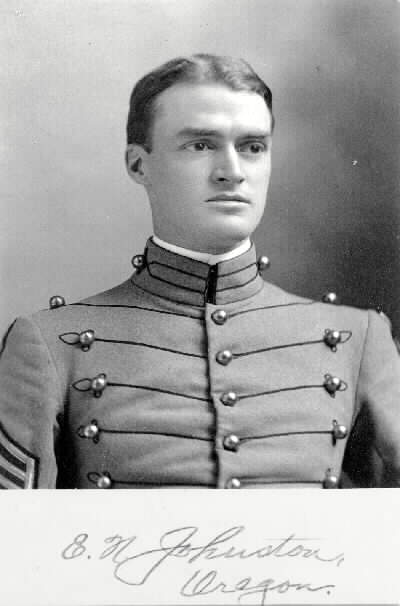The first graduate of the United States Military Academy Class of 1901 was Edward Neele Johnston. Hailing from St. Louis, Missouri, Johnston came from a very distinguished family line. His ancestors founded the Massachusetts Bay Colony, and one relative built the first church organ of New England in Salem in 1714. Another relative, Samuel Johnston, became the first president of Kings College, now known as Columbia University in New York City.
Before attending West Point, Johnston attended Washington College in Tacoma, Washington; Bishop Scott Military Academy in Portland, Oregon; and Leland Stanford University in California.
After graduation, “Mathy” was assigned to the 2d Battalion and stationed at Fort Totten, New York, and placed in charge of road and bridge construction. He then served in the U.S. with the 2d and 3rd Battalions of Engineers and was a student at the U.S. Engineer School and an instructor at USMA in the Department of Civil and Military Engineering. At the same time, he worked on the construction of the Lock and Dam Number 4 on the Ohio River.
His thesis was published and he invented an electrical movable distant control device for operating construction cableways. The patented rights eventually were sold to the General Electric Company.
Johnston was involved in many river and harbor projects that included the Mississippi River levee and bank protection; Keokuk Dam; the new lock at Sault St. Marie; Cumberland, Trinity, Ouachitas, Kentucky, and Ohio Rivers; and the jetties at Sabine Pass, Texas. He eventually was placed in charge of the U.S. Engineer office at Wilmington, Delaware, and was a member of the Board of Engineers for Rivers and Harbors.
In 1916, Johnston was placed in charge of all new construction and improvements of the Chesapeake Bay on the Delaware, New Jersey, and Maryland coasts. In 1917, he was assigned as Commander of the 23rd Highway Engineers at Camp Meade, Maryland, and went with this regiment to France in 1918.
He then served as Assistant Chief of Chemical Warfare Services, A.E.F., in France until 1918.
Colonel Johnston retired in 1924 after an illustrious military career. He received the Distinguished Service Citation, Distinguished Service Medal, Distinguished Service Order, and Legion of Merit.
He died in San Francisco, California, in 1936 at the age of 60. He was buried in Arlington National Cemetery with many classmates attending the services.
Michael Robert Patterson was born in Arlington and is the son of a former officer of the US Army. So it was no wonder that sooner or later his interests drew him to American history and especially to American military history. Many of his articles can be found on renowned portals like the New York Times, Washingtonpost or Wikipedia.
Reviewed by: Michael Howard

